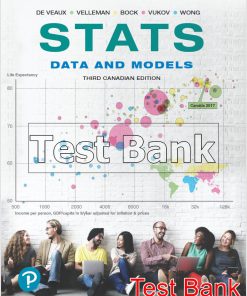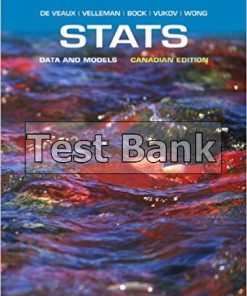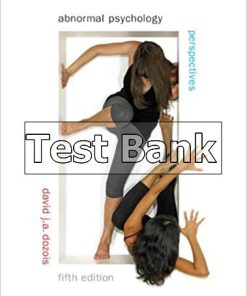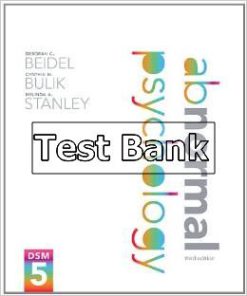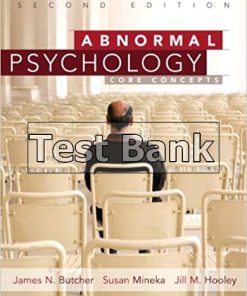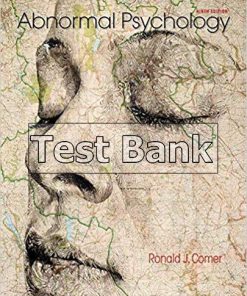Intro Stats 5th Edition Veaux Test Bank
$26.50$50.00 (-47%)
Intro Stats 5th Edition Veaux Test Bank.
You may also like
-
$26.50
$50.00 -
$26.50
$50.00 -
$26.50
$50.00
Intro Stats 5th Edition Veaux Test Bank

Product details:
- ISBN-10 : 0134210220
- ISBN-13 : 978-0134210223
- Author:
By using technology and simulations to demonstrate variability at critical points throughout the course, the authors make it easier for students to understand more complicated statistical later in the course (such as the Central Limit Theorem). In addition, students get more exposure to large data sets and multivariate thinking, which better prepares them to be critical consumers of statistics in the 21st century.
The 5th Edition’s approach to teaching intro stats is revolutionary, while retaining its lively tone and popular features such as Think/Show/Tell examples.
Table contents:
PART I: EXPLORING AND UNDERSTANDING DATA
1. Stats Starts here
1.1 What Is Statistics?
1.2. Data
1.3 Variables
1.4 Models 2. Displaying and Describing Data
2.1 Summarizing and Displaying a Categorical Variable
2.2 Displaying a Quantitative variable
2.3 Shape
2.4 Center
2.5 Spread 3. Relationships Between Categorical Variables — Contingency Tables
3.1 Contingency tables
3.2 Conditional distributions
3.3 Displaying Contingency Tables
3.4 Three Categorical Variables 4. Understanding and Comparing Distributions
4.1 Displays for Comparing Groups
4.2 Outliers
4.3 Re-Expressing Data: A First Look 5. The Standard Deviation as a Ruler and the Normal Model
5.1 Using the standard deviation to Standardize Values
5.2 Shifting and scaling
5.3 Normal models
5.4 Working with Normal Percentiles
5.5 Normal Probability Plots Part I Review
PART II: EXPLORING RELATIONSHIPS BETWEEN VARIABLES
6. Scatterplots, Association, and Correlation
6.1 Scatterplots
6.2 Correlation
6.3 Warning: Correlation ≠Causation
6.4 *Straightening Scatterplots 7. Linear Regression
7.1 Least Squares: The Line of “Best Fit�
7.2 The Linear model
7.3 Finding the least squares line
7.4 Regression to the Mean
7.5 Examining the Residuals
7.6 R 2–The Variation Accounted for by the Model
7.7 Regression Assumptions and Conditions 8. Regression Wisdom
8.1 Examining Residuals
8.2 Extrapolation: Reaching Beyond the Data
8.3 Outliers, Leverage, and Influence
8.4 Lurking Variables and Causation
8.5 Working with Summary Values
8.6 * Straightening Scatterplots–The Three Goals
8.7 * Finding a Good Re-Expression 9. Multiple Regression
9.1 What Is Multiple Regression?
9.2 Interpreting Multiple Regression Coefficients
9.3 The Multiple Regression Model–Assumptions and Conditions
9.4 Partial Regression Plots
9.5 Indicator Variables Part II Review
PART III: GATHERING DATA
10. Sample Surveys
10.1 The Three Big Ideas of Sampling
10.2 Populations and Parameters
10.3 Simple Random Samples
10.4 Other Sampling Designs
10.5 From the Population to the Sample: You Can’t Always Get What You Want
10.6 The valid survey
10.7 Common Sampling Mistakes, or How to Sample Badly 11. Experiments and Observational Studies
11.1 Observational Studies
11.2 Randomized, Comparative Experiments
11.3 The Four Principles of Experiment Design
11.4 Control Groups
11.5 Blocking
11.6 Confounding Part III Review
PART IV INFERENCE FOR ONE PARAMETER
12. From Randomness to Probability
12.1 Random phenomena
12.2 Modeling Probability
12.3 Formal Probability
12.4. Conditional Probability and the General Multiplication Rule
12.5 Independence
12.6 Picturing Probability: Tables, Venn Diagrams, and Trees
12.7 *Reversing the Conditioning: Bayes’ Rule 13. Sampling Distributions and Confidence Intervals for Proportions
13.1 The Sampling Distribution for a Proportion
13.2 When Does the Normal Model Work? Assumptions and Conditions
13.3 A Confidence Interval for a Proportion
13.4 Interpreting Confidence Intervals: What Does 95% Confidence Really Mean?
13.5 Margin of Error: Certainty vs. Precision
13.6 *Choosing your Sample Size 14. Confidence Intervals for Means
14.1 The Central Limit Theorem
14.2 A Confidence interval for the Mean
14.3 Interpreting confidence intervals
14.4 *Picking our Interval up by our Bootstraps
14.5 Thoughts about Confidence Intervals 15. Testing Hypotheses
15.1 Hypotheses
15.2 P-values
15.3 The Reasoning of Hypothesis Testing
15.4 A Hypothesis Test for the Mean
15.5 Intervals and Tests
15.6 P-Values and Decisions: What to Tell About a Hypothesis Test 16. More About Tests and Intervals
16.1 Interpreting P-values
16.2 Alpha Levels and Critical Values
16.3 Practical vs Statistical Significance
16.4 Errors Part IV Review
PART V: INFERENCE FOR RELATIONSHIPS
17. Comparing Groups
17.1 A Confidence Interval for the Difference Between Two Proportions
17.2 Assumptions and Conditions for Comparing Proportions
17.3 The Two-Sample z-Test: Testing the Difference Between Proportions
17.4 A Confidence Interval for the Difference Between Two Means
17.5 The Two-Sample t-Test: Testing for the Difference Between Two Means
17.6 Randomization-Based Tests and Confidence Intervals for Two Means
17.7 *Pooling
17.8 *The Standard Deviation of a Difference 18. Paired Samples and Blocks
18.1 Paired Data
18.2 Assumptions and Conditions
18.3 Confidence Intervals for Matched Pairs
18.4 Blocking 19. Comparing Counts
19.1 Goodness-of-Fit Tests
19.2 Chi-Square Tests of Homogeneity
19.3 Examining the Residuals
19.4 Chi-Square Test of Independence 20. Inferences for Regression
20.1 The Regression Model
20.2 Assumptions and Conditions
20.3 Regression Inference and Intuition
20.4 The Regression Table
20.5 Multiple Regression Inference
20.6 Confidence and Prediction Intervals
20.7 *Logistic Regression
Part V Review
People also search:
introductory statistics answers pdf
intro about statistics
statistics intro activity
intro to statistics and data analysis
intro stats 5th edition answers
khan academy intro to stats

